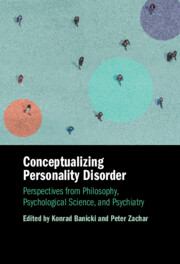 Conceptualizing Personality Disorder
Conceptualizing Personality Disorder A Complex Systems Perspective on Personality Disorders
from Part II - Contemporary Approaches to Traditional Conceptual Perspectives
Published online by Cambridge University Press: 25 June 2025
In this chapter we outline a theoretical perspective in which personality (relatively normal or dysfunctional) is the ultimate outcome (i.e. equilibrium state) of a mutualistic, dynamical system in which the building blocks of personality (i.e. components) interact with one another over time. These interactions give rise to dynamical couplings between thoughts, feelings, behaviours and environment. These couplings arise through multiple potential mechanisms, for example resource competition and a drive for consistency. As a result of particular architectures of the dynamical system, dysfunctional states can become stable features of the system, and we recognize these states as personality disorders. By means of a toy simulation dynamical model, we show some of the, potentially many, roads to developing personality disorders. Finally, we highlight four implications of our systems perspective on personality disorders on future research.
To save this book to your Kindle, first ensure no-reply@cambridge.org is added to your Approved Personal Document E-mail List under your Personal Document Settings on the Manage Your Content and Devices page of your Amazon account. Then enter the ‘name’ part of your Kindle email address below. Find out more about saving to your Kindle.
Note you can select to save to either the @free.kindle.com or @kindle.com variations. ‘@free.kindle.com’ emails are free but can only be saved to your device when it is connected to wi-fi. ‘@kindle.com’ emails can be delivered even when you are not connected to wi-fi, but note that service fees apply.
Find out more about the Kindle Personal Document Service.
To save content items to your account, please confirm that you agree to abide by our usage policies. If this is the first time you use this feature, you will be asked to authorise Cambridge Core to connect with your account. Find out more about saving content to Dropbox.
To save content items to your account, please confirm that you agree to abide by our usage policies. If this is the first time you use this feature, you will be asked to authorise Cambridge Core to connect with your account. Find out more about saving content to Google Drive.